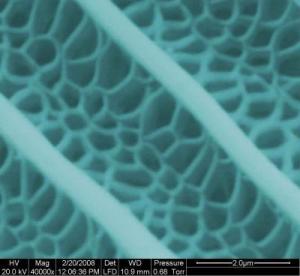A joint team of researchers from the University of Pennsylvania and the University of Madrid, Spain, developed a method to replicate biological structures, such as butterfly wings, on a nanometer scale. The resulting biomaterial could be used to prepare optically active structures, such as optical diffusers for solar panels.

The colors of the insects, their shimmering in a multitude of colors (their ability to change color depending on the angle) and their ability to appear in a metallic color are all determined by tiny photonic nanostructures found in their cover (cuticle, the outer protective layer). The scientists focused on these biostructures for the development of devices with light-emitting properties and their findings were published in the scientific journal Bioinspiration & Biomimetics.
"The method allows the exact reproduction of biological structures on a nanometer scale," explains the lead researcher, Raúl J. Martín-Palma. The researchers made exact independent replicas of fragile, multi-layered biopatterns of chitin, which mimic the nanostructures of butterfly wings. The appearance of these arrays often depends more on their periodic nanometric structure (which determines the "physical" color) than on the pigments found in their wings (which determine the "chemical" color).
In order to prepare new biomaterials, the research team used compounds based on the elements germanium, selenium and stebium (antimony) and a special chemical method called Conformal-Evaporated-Film-by-Rotation. In addition, they used immersion in an aqueous solution of phosphoric acid to dissolve chitin (a substance often found in the exoskeleton of insects and other arthropods).
The methods that have been used to date to mimic bio-structures are extremely limited when it comes to obtaining efficient replicas on a nanometer scale, and they usually damage the original bio-structure due to the conditions of a corrosive atmosphere or high temperature in which they operate. The new method completely overcomes these bumps and it takes place at room temperature and without the need to use toxic substances.
The researchers note that the structures obtained from replicating the biopatterns of the butterfly wings could be used to prepare various optically active structures such as diffusers or optical covers that will increase the light absorption of solar cells, or other devices. "Furthermore, the method can be used to replicate other biological structures, such as the beetle's shell, or the complex eyes of flies, bees and wasps," the researchers explain.
The compound eyes of some insects are good candidates for a large number of applications because they provide wide-angle vision. "The development of tiny cameras and optical sensors based on these organs could allow their insertion into tiny spaces in cars, phones and portable monitors, in addition to their use in fields such as medicine (endoscope, a device for examining and viewing internal parts of body organs) and security (electronic surveillance)," says the researcher the main
